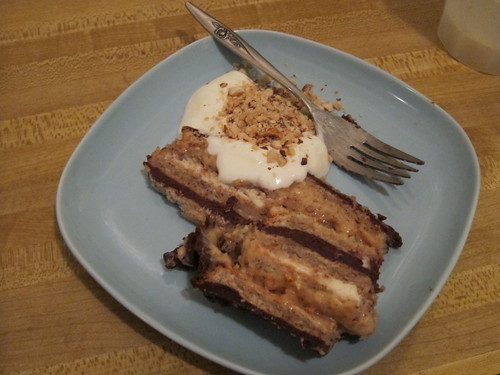So here is the marjolaine, after 36 hours of refrigerated resting:
You can't tell very well from my careful photography, but it's decidedly tilty. I'm not sure how I would improve that next time - perhaps trim the cake better before stacking.
Here is the final product:
That's actually a slice and a half, because it was all that was leftover and I am a piggy. If you just look at the longest rectangle shape in the center of the plate, that's what the marjolaine looked like. I served it with whipped cream/creme fraiche (whatever was leftover after the baking process: whip the cream, fold in sweetened creme fraiche) and ground toasted almonds & hazelnuts, since those were the nuts used in the cake layers.
It was fantastic. The wine group members loved it, and one said the result was on par with things her dad (a master German baker) produces - high praise indeed!
For future reference:
- It really is easy, and is best if you take 3 days to do the various bits. Starting on Sunday for a Friday reveal was perfect.
- I am not very skilled at caramelizing sugar (used to make the praline, used in the top layer). That was by far the most difficult step and I probably could have gone a bit darker, but got too nervous. Next time try to go just a trifle longer.
- I might make the ganache in two batches next time - 1/3 for the cake layer, and the other 2/3 for the frosting. Reheating the ganache was not easy and its texture was a tiny bit off.
- I used Guittard 72% bittersweet chocolate, because I thought the whole dessert would be quite sweet and wanted to offset it a bit. However I didn't love it mixed with the tartness of the creme fraiche, so next time I'll go a shade lighter with 61% semisweet. My local shop sells it for $10/pound which is the best price for the high-end chocolates I've found. I would also consider getting one of Trader Joe's big ol' pound-plus and chopping it up, but the discs in the Guittard box are very handy to work with.
- The trickiest layer to work with was the vanilla creme fraiche - the white layer in the middle. It was pretty runny, so I would work a bit harder to get it thickened and might consider researching additives like cornstarch or gelatin or cream of tartar to try to get it to stiffen better. Once it was refrigerated it was pretty good, but it was not easy to stack & wrap without the goo sliding out every which way.
- I would trim the edges of the cake before assembling to try to limit the tilt factor
- OR next time I'll cover the layers side by side, then stack & wrap quickly. That might be the easiest solution, actually.
- I made this with a gluten-intolerant friend in mind - the only thing I had to modify was using corn starch on the parchment paper, instead of flour. The recipe itself is naturally gluten-free.
- Next time I'll try making my own creme fraiche - apparently you just put some buttermilk into heavy cream, but that is a LOT cheaper than buying it already soured/thickened.
- The ingredients for the dessert ran about $25 - definitely the most expensive thing I've made.



I want to say I've read a tip (somewhere) that using strips of white paper is a good way to test the doneness of caramelized sugar. Not that I would know, since I'm still too chicken to try making caramel myself (it is on my not-written-down list).
ReplyDeleteThat's a good suggestion. I tried making it a few times in my Dutch oven but it just .. I dunno. Most of the time it gets all dry and crackly and just wrong. I think maybe the finish on the pan isn't perfect (due to its loving use!) so I tried a different pan this time. I've asked a friend whose partner is a pastry chef if she can recommend any local classes. I don't need to do it often enough in real life to really get a feel for it, and doing it on my own without any advice/oversight isn't a learning experience.
ReplyDelete